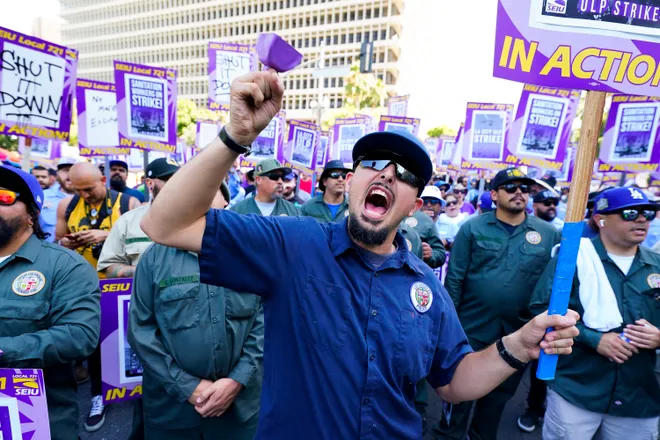Union membership hit a historic low in 2023, here's what the data says.

Despite an uptick in worker stoppages, boycotts and strikes last year, union membership remained at a historic low in 2023.
More than 500,000 workers walked off the job for better benefits, pay and/ or working conditions last year, according to Cornell University's Labor Action Tracker. In 2023 alone, over 400 strikes were recorded by the tracker. But the rate of union members is the lowest in decades at 10%, according to the Bureau of Labor Statistics (BLS).
A combination of labor laws unfavorable to unions and an uptick in corporate-backed union suppression tactics are two insights as to why union membership is so low in the 21st century.
In the 1950s, 1 in 3 workers were represented by a union. Now it’s closer to 1 in 10.
Workplace sectors that were traditionally union strongholds now make up less of the workforce, such as manufacturing, transportation, and construction, according to BLS.
Who belongs to unions now?
Between 2022 and 2023, trends in union membership slightly altered, with 14.4 million wage and salary workers belonging to a union last year, less than a 1% increase from 2022. Here's what the data shows:
- Nearly 33% of employees working in education, training and library occupations were represented by a union.
- They had the highest unionization rates of any workforce last year.
- Those working in protective service occupations, such correction officers, police, firefighters and security guards, were a close second with nearly 32% represented by unions, according to the labor statistics bureau.
Men historically have higher rates of union membership compared with women, but the gap between those rates has gotten smaller in recent years. Women now make up about 47% of all union members.
Black workers continued to have a higher union membership rates (11.8%) compared with white workers (9.8%), Asian workers (7.8%), and Hispanic workers (9%).
Summer of strikes:Here's why the US labor movement is so popular but union membership is dwindling
Which states have the most union-represented employees?
A quarter of workers living in Hawaii are union members, according to the labor statistics bureau. At least 19 states have higher rates of employees represented by unions compared with the national average. South Carolina had the lowest rate of employees represented by unions at 3%.
Almost 30% of all active union members lived in just two states (California at 2.5 million and New York at 1.7 million). These two states also accounted for 17% of wage and salary employment nationally, according to the BLS.
Why is it difficult for unions to form?
More than two dozen states have passed "Right to Work" laws, making it more difficult for workers to unionize. These laws provide union representation to nonunion members in union workplaces – without requiring the payment of union dues. It also gives workers the option to join a union or opt out.
Along with the passage of laws unfavorable toward labor unions, some corporations invest money into programs and consultants who engage in union-suppressing tactics, according to the Economic Policy Institute (EPI). A 2019 analysis from the EPI found that companies spent $340 million a year on "union avoiding" consultants who help deter organizers. And employers were charged with violating federal law in 41.5% of all union election campaigns.

Disclaimer: The copyright of this article belongs to the original author. Reposting this article is solely for the purpose of information dissemination and does not constitute any investment advice. If there is any infringement, please contact us immediately. We will make corrections or deletions as necessary. Thank you.






